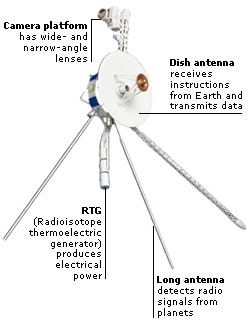DK Science: Interplanetary Missions
Scientists launch interplanetary missions to study the planets, asteroids, and comets close up. Mariner 2 was the first successful interplanetary craft flying past Venus in 1962. MARS EXPLORATION began with Mariner 4 in 1965. Since then all the planets except Pluto have been visited by interplanetary craft. Some spacecraft study their targets as they fly by, some orbit their targets, and others even land on them.

Two Voyager spacecraft are now winging their way out of the Solar System after highly successful missions to the outer planets that began in 1977. Both Voyager 1 and 2 flew past Jupiter and Saturn. Then Voyager 2 continued on to Uranus and Neptune, revealing their secrets for the first time.
The Magellan spacecraft went into orbit around Venus in 1990. It used radar to find out what lay beneath the clouds that permanently cover the planet. The images it sent back showed that the landscape of Venus was covered in huge lava flows from hundreds of volcanoes. There were also spidery cracks, called arachnoids, in the planet’s surface.
A spacecraft called NEAR-Shoemaker made an unexpected landing on the asteroid Eros in February 2001. It had spent the previous year in orbit around the 33-km (21-mile) rocky body, which sometimes comes within 22 million km (14 million miles) of Earth. At the end of the mission, the scientists decided to let the craft get closer and closer to the surface, taking pictures as it went. To their surprise, the craft survived quite a hard landing on the asteroid, and one instrument continued to work for several days afterwards.
In 2004 the Cassini spacecraft reached the beautiful ringed planet Saturn after a seven-year journey from Earth. The aim was to study the planet and many of its moons over a long period of time. Cassini was programmed to release a probe called Huygens into the thick atmosphere of Saturn’s largest moon, Titan, and to land it on the moon’s surface.
Some of the most exciting interplanetary missions have been to Mars, our neighbouring planet. Mars is the only other planet where life may once have existed and where human beings could possibly settle in the future. Mars is being explored in depth by spacecraft on its surface and in orbit around it. These missions have found a lot of frozen water in the Martian rocks, perhaps all that is left of ancient Martian oceans.
In January 2004, two robot vehicles called Spirit and Opportunity touched down on Mars and began moving slowly over the surface. They carried instruments to study rocks, and cameras to take pictures of the surface, and for navigation. Before every stage of exploration, each rover took pictures of the area directly ahead. These were used to plan a route, avoiding hazards, to the next target area.
The Mars Global Surveyor was launched in 1996 and reached Mars orbit 10 months later. In 1999, it began its main mission: to orbit the planet acquiring data in order to create a detailed picture of the Martian surface. It also mapped the topography (the three-dimensional landscape) of the planet, and studied the surface rocks and the atmosphere.
